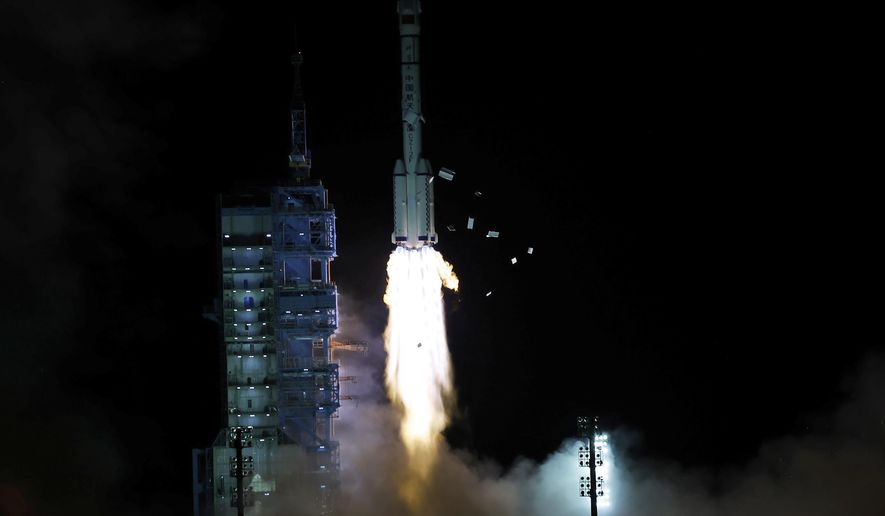China has launched a new satellite that analysts say can be used as a weapon capable of grabbing and crushing American satellites.
The Shijian-21 satellite was sent aloft on Sunday atop a rocket booster from the Xichang Satellite Launch Center, ostensibly for cleaning “space debris,” according to the China Aerospace Science and Technology Corp, Beijing’s state-run space company. The company stated that the satellite is “tasked with demonstrating technologies to alleviate and neutralize space debris.”
The robotic satellite launch followed a suspected recent test of a new hypersonic missile that Chinese officials said was a peaceful space experiment.
The commander of the U.S. Space Command, Air Force Gen. James Dickinson told Congress in April that spacecraft like the Shijian-21 is part of an effort by China to seek “space superiority through space and space-attack systems.”
“One notable object is the Shijian-17, a Chinese satellite with a robotic arm,” Gen. Dickinson said. “Space-based robotic arm technology could be used in a future system for grappling other satellites.”
The Shijian-17 satellite is used for communications and monitoring space debris. It is said to be capable of maneuvering close to orbiting satellites and grabbing or crushing the spacecraft.
Gen. Dickinson said the co-orbital robotic spacecraft is part of a growing arsenal of space weaponry fielded by the Chinese military.
The Shijian series of satellites were first observed in 2013 when three were launched and U.S. intelligence detected unusual movements by the crafts. The Shiyan-7, or (Experiment-7), Chuangxin-3 (Innovation-3) and Shijian-15 (Practice-15) satellites each weighed around 22 pounds or less.
Of the three spacecraft, the Shijian-15 was the most unusual, according to U.S. officials. The satellite carried a robotic arm with a pincher on the end.
Other Chinese space weapons include several types of ground-launched anti-satellite missiles capable of hitting satellites in low-, medium- and high-altitude orbits, and electronic jammers and lasers.
“We see their capabilities from direct-ascent ASAT, antisatellite capabilities, to on-orbit activity that they’ve done with that capability,” he said.
China’s space weapons build-up also is couched in deception, the general said. “All the while, China continues to maintain their public stance against the weaponization of space,” Gen. Dickinson said.
China has used civilian space development, like debris mitigation, as cover for testing co-orbital anti-satellite weaponry.
Michael J. Listner, a space security analyst, said identifying China’s capabilities is difficult because of the dual-use nature of space technology.
“Technology that has peaceful uses can be used for nonpeaceful uses,” he said.
Efforts during the 1960s and 1970s to ban ASAT systems were stymied by difficulties in verifying space technology. The development of missile defenses also compounded the verification problem.
In 2008, the U.S. military in what was code-named Operation Burnt Frost, used a modified anti-missile interceptor to shoot down a falling U.S. satellite.
The latest effort at co-orbital ASAT development through the Shijian-21 highlights the issue.
“A mission that could have a peaceful use in orbital debris mitigation could be employed as a co-orbital ASAT,” said Mr. Listner, with the firm Space Law and Policy Solutions.
China “says ‘trust us,’ but the classified nature of the mission and the PRC’s development of counter-space capabilities says otherwise.”
Retired Indian Col. Vinayak Bhat, a former imagery intelligence analyst, said the launch of Shijian-21 is suspicious because China has previously shown no interest in reducing space debris and has been launching larger rockets and increasing debris, he said.
“This robotic arm technology is inherently dual use and would most certainly be used as a space weapon to capture and disable/destroy enemy satellites,” Col. Bhat said. “China deploying such dual-use satellites strongly suggests [the Chinese Communist Party’s] intention to militarize space.”
A Defense Intelligence Agency report concluded that China’s military sees space warfare as a means of deterring and countering U.S. military intervention in a regional conflict.
“[People’s Liberation Army] analysis of U.S. and allied military operations states that ‘destroying or capturing satellites and other sensors’ would make it difficult to use precision-guided weapons,” the report said. “Moreover, PLA writings suggest that reconnaissance, communications, navigation and early warning satellites could be among the targets of attacks designed to ‘blind and deafen the enemy.’”
Chinese state media provide no additional details on the Shijian-21 launch.
The state-run China Daily stated small objects traveling at high speeds in space can deliver as much energy as a hand grenade. More than 100 million pieces of space debris are estimated to be in orbit ranging in size from several inches to floating garbage weighing several tons.
Around 50% of the space debris was the result of disintegrated spacecraft, said Liu Jing, deputy director of China’s Space Debris Monitoring and Application Center. Ms. Liu made no mention in the China Daily report of China’s 2007 ASAT missile test that left tens of thousands of dangerous floating debris in space.
Since the 2007 test and the world outcry against the test, China has not conducted similar ASAT missile tests, but instead has hidden its space warfare attack capabilities by disguising them as anti-missile tests or civilian research.
• Bill Gertz can be reached at bgertz@washingtontimes.com.




Please read our comment policy before commenting.